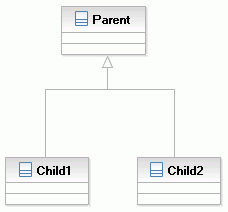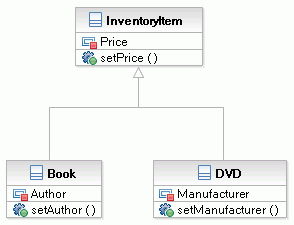To comply with UML semantics, the model elements in a generalization relationship must be the same type. For example, a generalization relationship can be used between actors or between use cases; however, it cannot be used between an actor and a use case.
You can add generalization relationships to capture attributes, operations, and relationships in a parent model element and then reuse them in one or more child model elements. Because the child model elements in generalizations inherit the attributes, operations, and relationships of the parent, you must only define for the child the attributes, operations, or relationships that are distinct from the parent.
The parent model element can have one or more children, and any child model element can have one or more parents. It is more common to have a single parent model element and multiple child model elements.
Generalization relationships do not have names.
As the following figures illustrate, a generalization relationship is displayed in the diagram editor as a solid line with a hollow arrowhead that points from the child model element to the parent model element.
Single parent with a single child |
Single parent with multiple children |
 |
 |
Example
The following figure illustrates an e-commerce application for a Web site that sells a variety of merchandise. The application has an InventoryItem class that is a parent class (also called a superclass). This class contains the attributes, such as Price, and operations, such as setPrice, that all pieces of merchandise use.
After defining the parent class, a child class (also called a subclass) is created for each type of merchandise, such as books and DVDs. The book class uses the attributes and operations in the inventory class and then adds attributes such as author and operations such as setAuthor. A DVD class also uses the attributes and operations in the inventory class, but it adds attributes such as manufacturer and operations such as setManufacturer, which are different from those in the book class.
